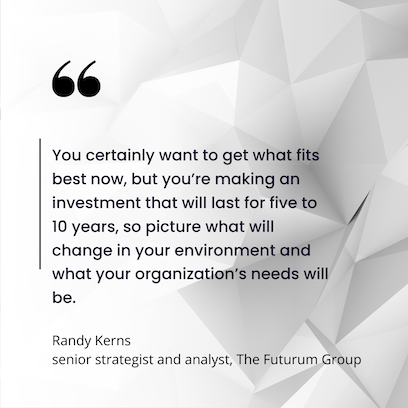When Data Storage Technologies No Longer Fit Your NeedsWhen Data Storage Technologies No Longer Fit Your Needs
As companies change, they may consider switching to new technologies. Here’s advice on how to select your next storage system.

About seven years ago, Simon Bacher and his wife came up with an idea for an interactive language learning app called Ling. They were fairly confident they could do everything on their own since Bacher had a background in software development and IT consulting.
When it came time to decide how to store the app's sound files and images, Bacher and his small team decided to upload the data to its own server, managing it themselves. But as Ling grew to 35 employees and more than five million users, the company needed to revamp the way they stored and managed that data. The homegrown storage system required custom code for any changes, suffered from reliability issues, and struggled with file updates.
After exploring various options, Bacher chose to switch from its system to the Firebase application development platform, which offers its own cloud storage. Firebase, now part of Google, allowed Ling to store all files on the platform while housing textual data in the Firebase database.
The choice of the Firebase platform was partly driven by its ability to instantaneously update files, making them readily available within the app. That’s something Firebase could do right out of the box.
Over the five years of using Firebrand, Bacher said that Ling hasn’t experienced any downtime.
Why We Change Data Storage Technologies
Making a switch in your data storage technologies can be motivated by many factors.
Dissatisfaction
Companies often seek a change due to dissatisfaction with their current storage technologies and practices. There may be too many bugs, a lack of vendor support, delayed updates, security vulnerabilities, or an impending end-of-life announcement from the vendor.
Costs
Cost considerations can play a major role, prompting reevaluation during maintenance or service contract renewals.
Accumulation of minor issues
Seemingly minor issues – sluggish performance, file read/write difficulties, errors, or system crashes – may accumulate over time and motivate a change.
External factors
At times, changes can stem from external factors that are outside the control of storage administrators, like new corporate goals or strategies. “When companies announce they are going to do an IT transformation, it may require a new type of storage,” said Randy Kerns, a senior strategist and analyst with The Futurum Group.
Technological considerations
Technological decisions, such as a wholesale shift to the cloud or to repatriate storage back in-house, may necessitate a change in storage systems.
FOMO
Fear of missing out on the latest and greatest storage technologies may spur companies to undergo an overhaul.
For Roman Surikov, CEO of app development company Ronas IT, multiple factors influenced his decision. Ronas IT had primarily used standard SQL databases with on-premises storage. However, as the company’s client base and data volumes grew, the company needed an infrastructure that could efficiently scale. Additionally, the company had reached a stage where it required real-time data processing and the ability to handle complex data structures. Other drivers included security, performance, and reliability.
“We realized it was time to change when our traditional data-handling mechanisms started proving to be inadequate for managing rapidly growing data volumes,” Surikov said. “The increase in ad-hoc scalability needs, paired with the quest for more performant solutions and increasingly diversified data, drove us towards this fundamental shift.”
Similarly, Peter Michaels, CEO of parental monitoring company Yeespy, sought new data storage technology when the existing system struggled to meet growing data demands. Moreover, Michaels said he felt that the current system had reached its end of life, with inadequate vendor support affecting customer satisfaction.
Finding the Ideal Storage Technology
When it’s time to change data storage technologies, what should be your first step?
Here’s what not to do.
According to Kerns, companies typically look to solve one particular problem and so choose storage to meet that need. This approach lacks foresight. “You certainly want to get what fits best now, but you’re making an investment that will last for five to 10 years, so picture what will change in your environment and what your organization’s needs will be," Kerns said.

Randy Kerns quote
Evaluating a storage vendor isn’t easy, but Kerns recommends researching the following factors:
Experience and longevity: Consider the vendor’s track record and how long they have been in the market.
Comprehensive offerings: Assess the completeness of the vendor’s storage offerings to ensure they can meet a range of your organization’s requirements.
Expense and consumption models: Do the vendor’s pricing models align with your organization’s budget and consumption patterns?
Research and development investment: Find out whether the vendor continually invests in R&D to stay up-to-date with emerging technologies and trends.
Ease of doing business: Talk with peer organizations to understand how easy and cooperative the vendor is to work with.
In Ronas IT's case, Surikov said the company sought replacement storage technologies that would are purpose-built for the job. That meant evaluating and adopting a host of technologies, including MySQL and MongoDB for document-oriented data handling and Debezium for data change capture.
To get to this point, Surikov’s team analyzed the diverse data storage requirements of the company’s range of applications. The team considered the type of data the applications would handle, data volume, growth rate, and the need for real-time access.
After compiling a shortlist of potential products, the team conducted pilot projects to evaluate performance, cost-effectiveness, scalability, ease of use, and the level of community support.
Michaels also embarked on an extensive evaluation process to find the ideal storage system for his company. He started by identifying key criteria such as performance, scalability, data protection, and cost-effectiveness. Seeking guidance from industry experts and trusted peers, he narrowed down the field to a few options.
The storage system Michaels chose impressed him for its state-of-the-art technology, robust scalability options, and advanced data protection features. He noted significant performance improvements and found the new system better equipped to accommodate the company’s growing data demands.
Despite being pleased with the new storage setup, Michaels said he wants keep pace with technological advancements and business growth. As such, he plans to regularly reevaluate storage strategies.
“We understand that technology is constantly evolving, and we must be adaptable to embrace future opportunities and stay at the forefront of innovation,” Michaels said.
About the Author
You May Also Like








.jpg?width=700&auto=webp&quality=80&disable=upscale)
